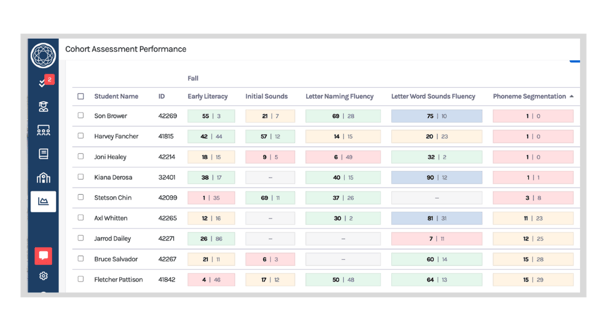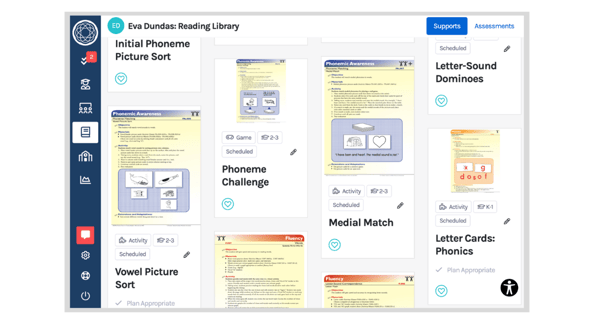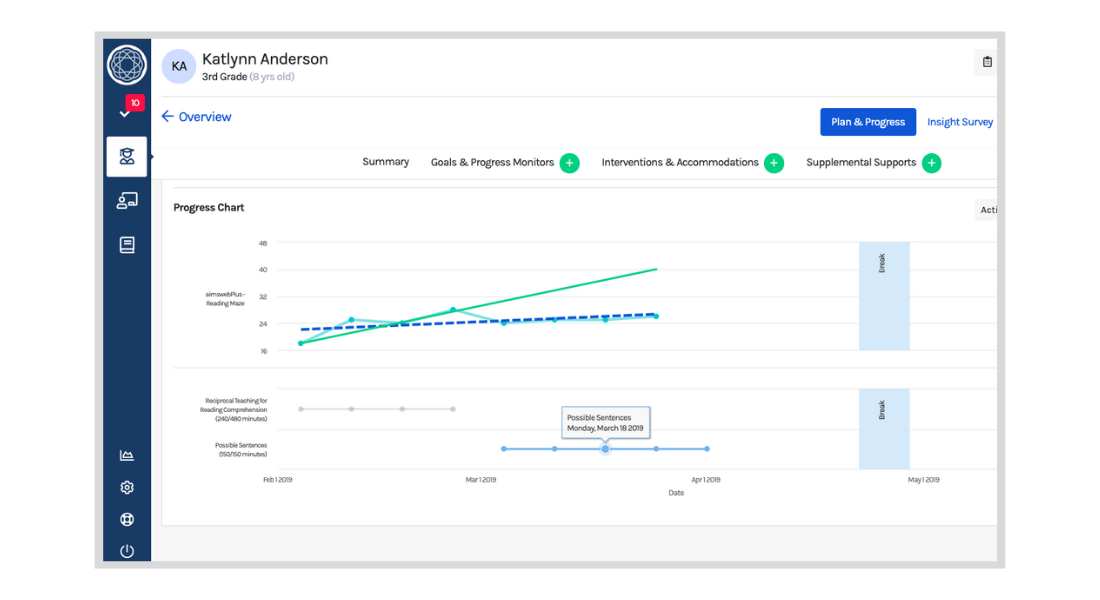Reading difficulty has an outsized effect on a student's ability to be successful in school and life. Dyslexia is defined as “a brain-based learning disability that specifically impairs a person’s ability to read.” (Stanley & Petscher, 2017). Reading ability can also be impacted by the “lack of education opportunity and appropriate literacy instruction.” (Dundas, 2023) Fortunately, research suggests early identification and intervention for dyslexia prevents further difficulty for the student. In fact, most states now have dyslexia legislation, which requires reading training for teachers and support for struggling students, according to the National Center for Improving Literacy.
This is where a Multi-Tiered System of Supports can benefit students with dyslexia. MTSS is designed to be preventative, using data to identify students at risk of adverse academic, behavioral, or social-emotional outcomes. When MTSS is implemented with fidelity, including quality universal screeners, educators can quickly catch and support those students showing signs of reading difficulty.
Here are a few ways that MTSS helps students with dyslexia, along with ways that the Branching Minds platform helps educators streamline this work and ensure that no student falls through the cracks.
MTSS and Dyslexia Highlights |
|
3 Ways that MTSS Supports Students with Dyslexia
1. Strong Tier 1 Instruction
With Strong Tier 1 instruction, students have access to evidence-based and differentiated resources. Explicit, systematic phonics instruction at younger grade levels fills any early gaps in language development and keeps students continuing with peers even if they receive additional Tier 2 interventions. There should be intentional scheduling to ensure students do not miss out on Tier 1 instruction.
Also, with high-quality curriculum materials, such as a structured literacy program, there is explicit instruction around those foundational language skills to build the phoneme-grapheme bridge before other literacy skills. This approach will be the most efficient and effective for all students. “Most children will learn how to read with balanced literacy or whole language programs under ideal conditions — but those approaches reinforce the wrong brain networks, which disproportionately affects children with dyslexia or who have not had appropriate educational opportunities.” (Dundas, 2023)
2. Identify Early
An essential practice within MTSS is to use a norm-based universal screening assessment to identify struggling readers and decide which students need more support. Students who do not meet reading benchmarks compared to their peers should be provided with timely, targeted interventions to prevent further difficulties.
Here are a few reading skills that should be covered by universal screening for dyslexia:
- Phonemic Awareness: The general ability to recognize and manipulate phonemes or language sounds
- Rapid Automatized Naming: A measure of the ability to quickly recall names from phonological memory
- Alphabetic Principles: To be able to understand those sounds, to quickly recall the names of those sounds, and match those to the visual representations
- Word Reading: Bringing the graphemes together in terms of whole word reading
Identifying which areas students need support will help teams plan those targeted interventions and monitor progress. MTSS is built on the idea of a cyclical evaluation, so a student receiving support will continue to be monitored, and their plans adjusted as they progress or not.
3. Wrap Around Supports
When students struggle in reading or any area in school, they often lose confidence in their abilities. This can impact how they manage their anxiety around school or how they perceive learning in general. MTSS as a framework addresses not just the academics, but the whole child. Wrap-around supports could include working with a counselor or learning techniques to cope with negative thoughts and other difficulties. It is key for educators to monitor and collaborate with other team members to help struggling students.
Kristen Beesaw, Assistant Director of Interventions and 504 of Bryan ISD, says this about supporting the mental health of students with dyslexia:
“When we are looking at MTSS and the whole child, (social-emotional health) is also a piece that has to be addressed – building of confidence and self-esteem that's not related to reading. We are going to take care of their reading with the dyslexia intervention. However, it's the other pieces of the child that we have to make sure that we're also taking care of.”
How Branching Minds Supports Students with Dyslexia
Screening Data
The Branching Minds platform allows you to quickly catch students falling behind in reading. Screening for reading, seeing all the data in one place for all students, and easily accessible individual student data make reading issues immediately apparent. For example, the Cohort Assessment Performance Report (CAPR) identifies students with similar needs, such as phonemic awareness. It is then easy to group students for targeted intervention in that area.

Using that data, teams can create Tier 2 support plans within the platform, built around smart goals and visible to the whole team.
Insight Survey
Another way the Branching Minds platform supports students with dyslexia is that teams can use the Insight Survey for Reading to help identify WHY the student is struggling, not just the fact that they are struggling. The Insight Survey compiles the observations of those who work directly with the student and then highlights the most foundational issues of concern, whether phonemic awareness, vocabulary, or whatever the issue might be. The Insight Survey helps teachers understand what these foundational skills are, why they are important for reading, and what it’s like for a student struggling with those skills. There are also Insight Surveys for math and behavior. Using the Insight Surveys, teams can identify and prioritize specific areas where a student needs help.
Intervention Library
To build effective support plans, teachers need research-based resources targeted to their student’s specific needs. Enter the Branching Minds Intervention Library. The library is carefully curated and aligned with Insight Surveys to provide recommended interventions appropriate for each student. These can be assigned to groups or individual students and include the what, why, and how of the intervention, increasing the likelihood that interventions will be implemented with fidelity.

Progress Monitoring
Another essential aspect of supporting students with dyslexia is to use progress monitoring assessments to see the trajectory of skill development and compare with peers. Progress monitoring can help us gauge whether or not our support intensity is working for students and distinguish between students who need additional support because they haven’t had sufficient educational opportunities or are having difficulty because of dyslexia. (Dundas, 2023)
Within Branching Minds, data is compiled visually to provide a quick snapshot of student progress and highlight whether student plan changes are needed.

If a student is not making progress, then the intensity of support may need to be increased for targeted interventions. “When we're talking about potentially students with dyslexia, we want to make sure we're giving you at least 120 additional minutes of the week with evidence-based intervention that is targeted for those foundational reading skills like phonemic awareness and phonics.” (Dundas, 2023)
Branching Minds and Dyslexia
Branching Minds can support students with dyslexia! MTSS provides a preventative framework and guidance for early identification and support for those students who show signs of early literacy struggles. Early intervention makes all the difference in building a strong foundation for reading.
Identifying and Supporting Dyslexia Within an MTSS Practice
Additional resources:
-
Listen to Schoolin' Around Podcast Episode: How MTSS Supports Students with Dyslexia: A Conversation with Kristen Beesaw (Spotify, Apple, Soundcloud)
-
Learn more about Progress Monitoring: How To Use Progress Monitoring Data To Guide Decision Making in MTSS
-
Learn more about Tier 2 Interventions: What You Need To Know About Utilizing Tier 2 in MTSS
Citations/Resources:
- Dundas, Eva. 2023. “Identifying and Supporting Dyslexia Within an MTSS Practice.” Branching Minds Webinars.
- Johnston, P., and D. Scanlon. 2021. “An Examination of Dyslexia Research and Instruction With Policy Implications.” Literacy Research: Theory, Method, and Practice 70, no. 1 (November): 107-128.
Support All Students with Branching Minds 💪

About the author
Larissa Napolitan
Larissa Napolitan is the Content Marketing Manager at Branching Minds and host of the Schoolin’ Around podcast, where she spotlights innovative voices and practices shaping education today. A former middle school teacher and instructional coach, Larissa draws on her classroom experience to create meaningful content that connects research, storytelling, and practical insights for school and district leaders. She is passionate about amplifying educator voices and supporting the growth of all students.

Your MTSS Transformation Starts Here
Enhance your MTSS process. Book a Branching Minds demo today.


















.png?width=716&height=522&name=The%20Power%20of%20Good%20Data%20(blog).png)